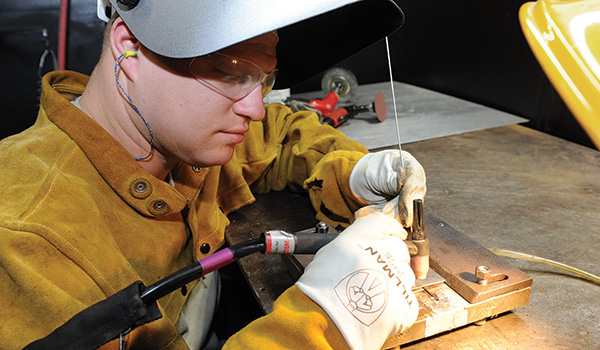
AMCOM Command Sergeant Major / By CSM Glen Vela: As the Army continues to reshape both structure and manning levels, leaders at all echelons are faced with the challenge to accomplish their missions with fewer soldiers. Within the aviation community, this challenge is compounded by an aging fleet that in some cases requires more man-hours to maintain.

A Soldier trains on advanced welding techniques at Corpus Christi Army Depot. / U.S. ARMY PHOTO BY CCAD PUBLIC AFFAIRS
It is essential to have highly qualified and skilled mechanics and crew chiefs if equipment readiness targets are to be achieved under these conditions. Providing these mechanics and crew chiefs will require a renewed focus on training, leadership and complete dedication to fleet readiness.
Hands-on Approach
Leaders must be deeply involved in Soldier training if we want to ensure our Soldiers are the best at their jobs. Training and mentoring must begin when a Soldier arrives at a unit from AIT as they are impressionable and ready to learn and grow their Soldier skills. Good leadership is critical at this time if effective, high quality training is to take place. Soldier maintenance skills will be honed by appropriate on the job training (OJT) as leaders progressively assign opportunities to learn. Development through OJT requires constant NCO supervision until the Soldier achieves proficiency and can be trusted to perform tasks with minimal supervision. This level of engagement means supervisors get out of the office and on the flight line and hangar floor (Stripes on the flight line). This hands-on approach enables leaders to provide realistic and meaningful Soldier training and mentoring.
Phase Team Leader Training
An effective Phase Team Leader training program is an essential element of a quality aircraft phase program. The Aviation and Missile Command (AMCOM) published a Phase Team Leader Guide to assist aviation units in developing a solid program foundation. As Soldiers develop their competency through OJT, leaders must identify those potential Phase Team Leaders before they become NCOs. These Soldiers will be the ones demonstrating technical ability as well as leadership qualities. Once selected, these Soldiers should be integrated into the planning and execution stages of aircraft phases as “Assistant Phase Team Leaders.” Senior leaders must monitor and evaluate the progress of these Soldiers and when they reach proficiency, graduate them to become genuine Phase Team Leaders.
Aircraft Mission Readiness
As with our forebearers, we must get back to the mentality of putting the “Horse First.” In our case, this means putting the readiness of the aircraft and the mission first. Just like Cavalry Soldiers took care of their horses every day, we too must make certain we take care of our aircraft every day to ensure we are ready for any mission. The Army Chief of Staff’s number one priority is mission readiness. For us, that translates to aircraft mission readiness. Just because it’s 17:00 should not mean we shut down operations and let aircraft accrue downtime overnight or over the weekend. Our “Brothers” in combat will not often call on us to man grenade launchers or tanks, but they will call on us for mission-ready helicopters. If parts are available, every effort should be made to bring the aircraft back up to a Fully Mission Capable (FMC) status to maintain fleet readiness posture.
Training Resources
Unit leaders are responsible for their Soldiers and aircraft, but they are not alone. There are numerous training resources within Army Aviation to assist leaders as they manage Soldier training. Some of these are formal and some are available if leaders seek out developmental opportunities that may not be obvious.
Corpus Christi Army Depot (CCAD) offers a range of training to Army Aviation maintainers who are seriously interested. In addition to focused technical training, CCAD will provide Soldiers with an in depth view of training performed at the depot level as well as greater knowledge of aircraft component form and function. CCAD also offers LAR University which will provide invaluable training to NCOs who wish to enhance their aircraft maintenance knowledge. I highly recommend Soldiers and NCOs take advantage of the training opportunities offered at CCAD.
Other training is available through partnering with National Guard and Army Reserve aviation units. Often when CABs deploy they are unable to take all their maintenance personnel. Rather than allowing skills to atrophy, connect with area Guard or Reserve units. An exchange with their maintenance units will be beneficial to both their Soldiers as well as helping to maintain skill sets for rear detachment Soldiers.
It never ceases to amaze me how dedicated and professional our Army Aviators and maintainers are at keeping our aircraft fleet ready to train or deploy. With a renewed focus on maintainer training and leader development, Army aviation maintenance will meet the challenges of a leaner manning picture and a more deployable structure while keeping the fleet mission ready at all times.
Above the Best and Army Strong!
CSM Glen Vela has served as the command sergeant major of the Aviation and Missile Life Cycle Management Command at Redstone Arsenal, AL since October 2014 after serving more than 5 years as an aviation brigade command sergeant major for 166th Aviation Brigade and 1st Air Cavalry Brigade, Fort Hood, Texas.










